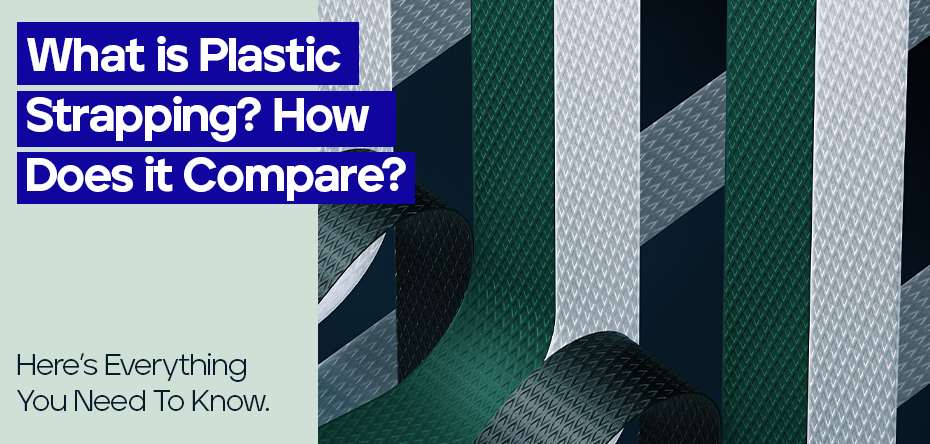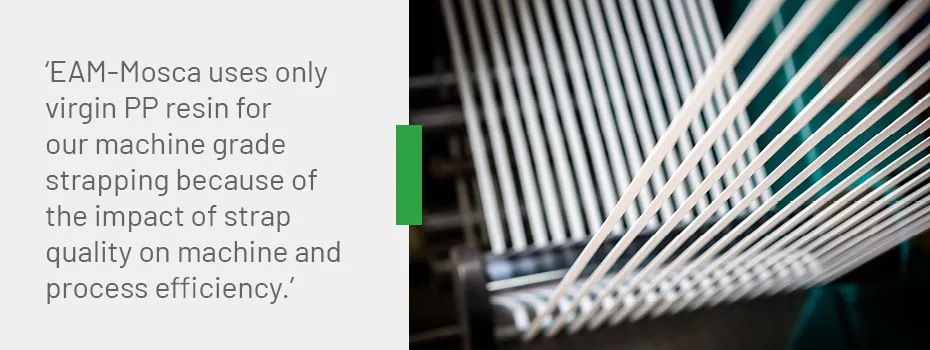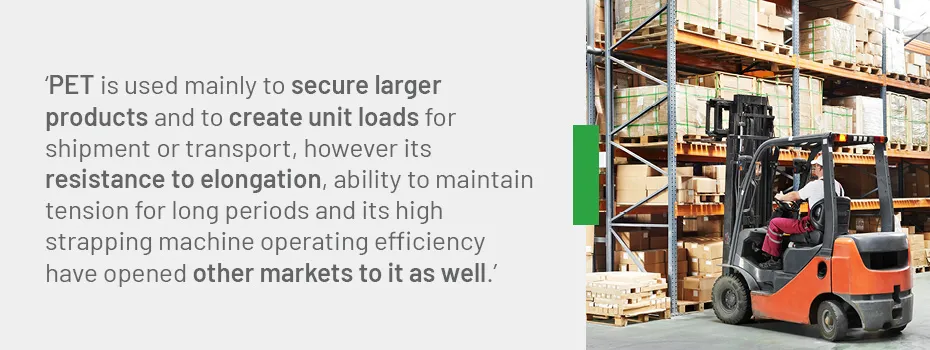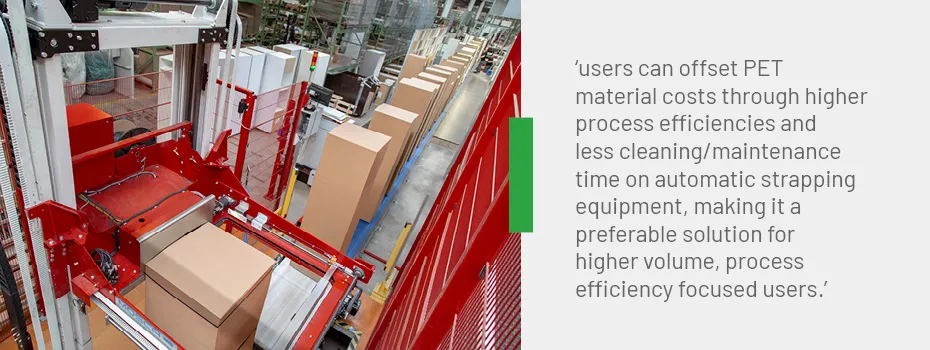What is plastic strapping? How does it compare? Here’s everything you need to know!
What is Plastic Strapping?
Plastic strapping is a high tensile strength banding material that is used in a wide variety of packaging applications including carton closing, bundling, plastic tote security, and tying together (unitizing) both palletized and unpalletized materials for in-plant transfer and shipment. Plastic strapping is economical, offers a unique combination of high strength with elasticity, is material-efficient and recyclable. Plastic straps are moisture-resistant and are effective across a wide temperature range. Plastic strapping can be used for outdoor storage for limited periods with UV stable grades available where extended environmental stability is needed.
What is Plastic Strapping Made From?
Plastic strapping is made primarily from one of two different plastic resins: Polypropylene (PP) or Polyester (PET). Nylon is another option however nowadays much less common. Polypropylene strap is typically made from virgin resins or a virgin/recycle blend depending on the quality required for the strap’s intended use. EAM-Mosca uses only virgin PP resin for our machine grade strapping because of the impact of strap quality on machine and process efficiency. EAM-Mosca manufacturers its PET strapping with up to 100% recycled content, consisting of recycled bottle flake or reprocessed pellets since PET can be continually enhanced to near virgin quality between each use.
How is Plastic Strapping Manufactured?
Commercial PP and PET strapping are manufactured using one of two extrusion processes. Multi-strand extruded straps, the most common type, are individually extruded through a multi-opening die, then heated, stretched, annealed, cooled, and coil wound. Stretching aligns the polymer chains in the plastic along its length, increasing the strand’s tensile strength and making it an effective packaging material. Sheet extruded straps start with a wide extruded sheet that is oriented in both length and width directions and is slit to the final width. Its tensile strength is less than a similarly sized strand-extruded strap but other characteristics may make it a good choice for operation in some older machine designs.
Strap surfaces may be embossed or smooth. Embossing, a pattern impressed into the strap surface, is most common. It improves strap performance by adding stiffness and reducing surface friction for improved machine feeding and can improve weld strength. Smooth straps often have a lubricant added to their surface to increase feed and weld reliability.
Coils are wound on paper cores in lengths from a few thousand to more than 25,000 feet per coil depending on strap size and type. Typical coil weights are approximately 30 pounds for polypropylene and 50 pounds for polyester strapping. However, this can vary based on the strength of the strap and the footage on a coil.
What is Polypropylene (PP) Strap?
PP strapping is the highest volume plastic strap due to its versatility and low cost. When standard PP strap is tensioned to its working range, 20-40% of its breaking strength, it typically elongates by about 4-10%, providing tight straps with significant elastic recovery. It is stable from freezing temperatures to the upper range of ambient temperatures. It can also be used for outdoor storage for limited periods. Industry guidelines suggest 30 to 90 days of UV life depending on sun intensity and color. Black is best for outdoor use. PP strap is water and moisture resistant. It is used in many general duty applications including for a variety of bundling, carton closing, and tote security requirements.
Are There Multiple Grades of PP Strap?
PP strap is made in hand and machine grade qualities. Hand grade strap is made with lower grade resins and is subject to relatively loose quality parameters. It can be applied manually with hand tensioners and its ends can be sealed mechanically with metal seals or buckles, or with a friction weld using a powered hand tool. Machine grade straps require a higher-grade resin that enables tighter process control, yielding more uniform dimensions and less camber or curvature when coil wound, to achieve high reliability when run through automatic power strapping machines. While PP strap costs tend to vary with crude oil markets, it remains an inexpensive and cost-efficient packaging choice for applications where its capabilities match requirements. EAM-Mosca sells only machine-based strapping systems and manufactures machine grade PP straps in widths from 5-12mm and breaking strengths from 100 to over 600 pounds.
What are Typical PP Strapping Applications?
EAM-Mosca supplies machine grade PP strap for a wide variety of applications including:
- Zipcode sorted mail bundling
- Securing postal mail trays
- Bundling stacks of newspapers for distribution
- Bundling laundry and linens for commercial laundries, hotels, hospitals, and care facilities
- Securing coils of wire
- Bundling, lengths of wood molding, and metal and plastic tubing
- Bundling sheets of wood veneer
- Tying protective packaging to windows and doors
- Securing plastic totes of controlled substances and high-value items for drug and convenience stores
- High-speed bundling of stacks of corrugated boxes
- Strapping corrugated packaging around cabinets and furniture
- Closing telescoping cartons of meat, poultry, and seafood
- Many other applications.
What is Polyester (PET) Strap?
Polyester strapping is a low elongation plastic strapping with qualities often referred to as “steel-like”. When tensioned to its working range, 20-40% of its breaking strength, standard PET will elongate approximately 2-6%. While this elongation is less than PP, PET maintains initial tension, staying tighter on packages, for a longer period than PP straps. PET is relatively unaffected by temperature from freezing to the upper levels of ambient temperatures. Standard PET stands up to UV deterioration for several months and special formulations are available if longer storage times are needed. PET is commonly used to secure larger and heavier loads for in-plant transfer, storage and shipment. Its characteristics make it the preferred solution to contain expanding or hard to restrain products, packages that tend to settle and products that are warehoused for relatively long periods.
Are There Multiple Grades of PET Strap?
Some manufacturers offer both hand grade and machine grade PET strap. EAM-Mosca is a machine application-focused supplier and is strictly a machine grade PET manufacturer. Because PET strap is inherently stiffer, less prone to camber than PP strapping, and creates less dust when running through strapping machines, it is a superior performing machine strap. EAM-Mosca manufactures machine grade PET strapping in widths from 9mm (3/8”) to 12mm (1/2”) and up to 750 lb. break strength.
What are Typical PET Strapping Applications?
PET is used mainly to secure larger products and to create unit loads for shipment or transport, however, its resistance to elongation, ability to maintain tension for long periods, and its high strapping machine operating efficiency have opened other markets to it as well. EAM-Mosca’s applications include:
- Unitizing loads of knocked-down corrugated boxes for shipment from box plant to user
- Securing bulk pallet loads of plastic, glass, and metal beverage and food containers for shipment from container manufacturer to filler
- Securing corrugated packaging around cabinets and furniture in situations where superior machine performance and its ability to remain tight to maintain package integrity during storage are important user priorities.
- Securing pallet loads of heavy automotive batteries for shipment
- Securing pallet loads of printed material for shipment from printer to postal centers
- Unitizing lumber and building materials including wallboard and brick
- Restraining cotton and man-made fiber bales.
Is PET Strap Used for Applications Other Than Pallets and Shipping Units?
Yes, although PET strapping use in non-unitizing applications has been limited by machine manufacturers’ ability to effectively seal it in their smaller machines and bundlers. Most machines in this sector use a hot blade to melt and seal strap ends. The smoke from sealing PET this way can be harmful and potentially carcinogenic to humans, making the combination unsuitable. The EAM-Mosca SoniXs® ultrasonic sealing system makes excellent seals with PET with no perceptible emission. Combined with PET’s machine and on-package performance characteristics, Mosca bundlers and PET strap make an effective and economical system for strapping smaller/lighter products as well. Applications, where PET and Mosca SoniXs® bundlers are used, include:
- Office furniture packaging
- Outdoor furniture packaging
- Cabinet packaging where PP tends to loosen during storage
- Doors/windows including heavy hurricane resistant products
- Securing unit loads of empty plastic detergent bottles from manufacturer to filler
- Banding individual shock absorbers at a compressed dimension making them easy to insert into their operating position at auto repair shops.
How do PP and PET Costs Compare?
EAM-Mosca’s machine grade PP is made from virgin resin and costs tend to vary roughly with crude oil prices. PET is made from recycled material and costs are less variable. PP cost per foot is generally less than a similar size PET strap, but PET has other positive performance characteristics. PET strapping’s strength, stiffness and elongation resistance may allow the use of a dimensionally smaller strap than with PP. Also, users can offset PET material costs through higher process efficiencies and less cleaning/maintenance time on automatic strapping equipment, making it a preferable solution for higher volume, process efficiency-focused users.
Does Plastic Strapping Compete with Steel Strapping?
Low PP strapping cost and significantly different characteristics minimize overlap between PP and steel strapping. PET strapping and steel do compete in some circumstances, typically for securing larger, heavier loads for shipment. PET strapping’s advantages include:
- Lower cost
- Safer to use given its softer edges and less snap-back when straps are cut for removal
- Ability to absorb shock loads
- Less damaging to product edges
- Does not leave rust marks
- Longer, lighter weight coils are easier to handle and more process efficient
- Less wearing on application machinery
Steel strap advantages include:
- Resistance to elongation provides stability for very heavy, hard to secure products
- Less sensitive to sharp product edges, if corner protection isn’t used
- Effective across a wider temperature range
- Less sensitive to UV degradation if products are stored outside for long periods
- Can be made in a higher breaking strength than PET for extremely heavy-duty applications
Is Plastic Strapping Recyclable?
Yes. PET is recycled plastic Number 1, and PP is recycled plastic Number 5. Plastic strapping is typically not permitted in residential curbside recycling programs, but commercial and industrial facilities that have relationships with local recyclers are able to incorporate it into the recycling stream. EAM-Mosca’s PET strapping has some stabilizers and color added but is 94-97% Polyethylene Terephthalate. PP strap is 99% polypropylene. Because PET quality can be enhanced after recycling, there is a strong market for recycled material nationwide. PP degrades with each use and the market for recycled PP is less universal but still widespread. Many items from lawn furniture to carpet backing utilize recycled PP. Most recyclers require strap to be chopped into +/- 6-inch lengths, boxed and labeled for pickup. There are several commercial strap chopper brands available for this purpose.
EAM-Mosca PET strapping is manufactured with up to 100% recycled PET materials. Along with its post-use recyclability, it is a highly sustainable packaging choice.
What Other Products Compete with Plastic Strapping?
Glue systems, plastic self-adhesive and gummed paper tapes and staples, are effective for sealing regular slotted cartons (where box flap edges align). Glue and staples hold flaps closed while tape seals the joints. They are widely used in parcel shipment. Plastic strapping is the packaging material of choice for larger or heavier boxes where package reinforcement is needed. It is also a preferred solution for telescoping carton (box top slides over bottom) securing and reinforcement.
Stretch film is a popular and effective material for securing palletized and unpalletized shipping units. It is especially preferred for unstable stacks of multi-layered items where it provides a containment shell to maintain load integrity and cleanliness during handling and transport. Strapping is also used for shipping unit securement, often along with stretch wrap to stabilize stacks of layers of product that complement the stability-enhancing and cleanliness benefits of stretch wrap. Strapping can be a less expensive, lower plastic use alternative to stretch wrap and provide faster throughput for the shipper, while simplifying post-use waste handling and recycling for the receiving party.
Shrink film is a more specialized packaging that requires a special plastic film that is activated by a device that applies heat to it. In a typical application, a “shrink bag” is placed over the object to be packaged, and when heat is applied the bag contracts forming a tight, seamless skin around the package. It is an appropriate packaging method for products that require high levels of protection for reasons of product integrity, cleanliness and/or security. The technology is available for a wide range of products from small cosmetic packs to boat covers for winter storage. It can be applied using hand-held
heating tools and fully automatic “shrink tunnels”. Strapping and shrink packaging rarely compete head to head but occasionally work together. An example is packaging zip code sorted bundles of magazines that are strapped for stability and then shrink-wrapped for protection during transport and handling within the postal system.
Glossary of Strapping Terms:
Break Strength: The maximum tensile force at which a strap will fail.
Bulk load: A multi-item product grouping, typically in stacks or layers that is not held together by a box, crate or similar restraint
Bundler: A strapping machine typically used to strap individual items or small bundles of products into a secure package.
Camber: A measure of the curvature of a length of strap as it is taken off a coil. Excessive camber will affect the strap’s performance in a strapping machine.
Elongation: The amount a strap stretches, as a % of original length, when tension is applied
Emboss: a pattern rolled onto a strap’s surface during manufacture, to enhance machine performance
Extrusion: A fabrication process where a material is melted and pushed via a screw or similar device, through a die with one or more openings, into a desired shape.
Orientation: Alignment of polymer chains through stretching a plastic strip giving it a high tensile strength and other qualities valuable in packaging applications.
PP: Polypropylene, an oil derived polymer plastic
PET: Polyethylene Terephthalate, commonly called polyester, a polymer fabricated from natural gas.
Recovery: A plastic strap’s elastic characteristics that enable it to maintain tension on a settling package.
Regular slotted carton: a standard box design where top and bottom flaps fold in alignment. Often used for parcel shipments and secured by tape, glue or staples.
Shingling: Phenomenon where layers of product are misaligned and in a partial overlap condition similar to roof shingles
Slit: the process of cutting a wide plastic sheet into multiple narrower strands.
System Approach: EAM-Mosca strategy of supplying all elements, including machines, strap, service and parts needed to maintain the highest system performance over its operating life.
Telescoping carton: 2-piece box design where top slides over bottom, often secured with plastic straps.
Tensile strength: The strength of a given strap per unit cross-section, measured in lbs. per square inch.
Tension: Tensile force applied to a strap to tighten it on a given package
Working tension range: The amount of tension applied to a strap to tighten it on the product while elongating it to provide the elastic recovery needed to keep it tight during transport and storage.
Unit load or Shipping unit: Multiple items tied together to form a single entity usually in preparation for transport.
Unitizer: A strapping machine that ties a multi-item grouping together into a single unit load
UV: Ultra-violet light from the sun that tends to degrade exposed plastics over time
Looking for strapping materials? View the multitude of products that we offer here!





